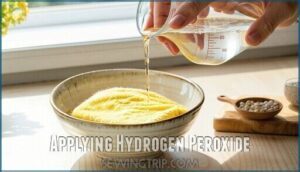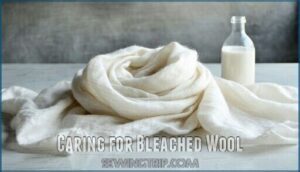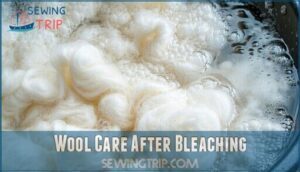This site is supported by our readers. We may earn a commission, at no cost to you, if you purchase through links.
 You can’t use regular chlorine bleach on wool – it’ll destroy the fibers and ruin your garment.
You can’t use regular chlorine bleach on wool – it’ll destroy the fibers and ruin your garment.
Instead, try oxygen bleach or hydrogen peroxide mixed with cool water. Test a hidden spot first, then soak your wool item for 30 minutes max.
Gently rinse with cool water and lay flat to dry. For stubborn yellowing, lemon juice works as a natural alternative.
Never use hot water or wring the fabric, as wool’s protein structure is delicate. The secret to successful wool bleaching lies in patience and the right temperature control techniques.
Table Of Contents
Key Takeaways
- Use oxygen bleach or hydrogen peroxide instead of chlorine bleach – you’ll protect wool’s protein structure and avoid permanent damage or felting
- Test any bleaching solution on a hidden area first – you can’t undo damage once it happens, so this step saves you from ruining the entire garment
- Keep water cool and limit soaking to 30 minutes max – hot water and extended exposure will shrink or felt your wool beyond repair
- Lay flat to dry and never wring the fabric – wool’s delicate fibers need gentle handling throughout the entire process to maintain their shape and integrity, and prevent permanent damage
Bleach Wool Safely
You can safely bleach wool with the right approach, but it requires careful attention to prevent damage.
The key is choosing gentle methods and testing on a small area first to avoid shrinking, felting, or weakening the fibers.
Assessing Wool Type
Your wool’s genetics matter more than you think.
Check fiber diameter first—Merino breeds offer superfine fibers under 18.5 microns, while Romney sheep produce coarser wool above 30 microns.
Examine staple length and wool strength by gently tugging a strand.
Fine wool grades need gentler bleaching methods than robust, coarse varieties.
Choosing Bleaching Method
Now you need to pick the right bleaching method for your wool. Your options depend on how delicate your fabric is and what results you want.
Here are your four main bleach types for wool whitening:
- Hydrogen peroxide – Gentlest option with 3-6% concentration levels for safe bleaching wool
- Oxygen bleach – Eco-friendly bleach alternatives wool lovers prefer for delicate fabrics
- Enzyme treatments – Natural approach using temperature control around room temperature
- Sunlight exposure – Free method requiring proper application techniques and safety precautions
Choose based on your wool’s condition and desired whitening level. Some may even consider using hydrogen peroxide wool for specific applications.
Preparing Wool for Bleaching
Before you start bleaching wool, proper preparation sets you up for success.
Begin with fiber assessment to understand your wool’s condition and dye content. Start washing methods by gently hand-washing in lukewarm water to remove surface dirt.
For greasy fleeces, degreasing wool with mild detergent helps bleaching agents work better. Test pH levels first – wool prefers slightly acidic conditions.
Bleaching wool, like bleaching delicate cashmere, is generally not recommended. Skip mordant use unless you’re planning to dye afterward, as it can interfere with bleaching wool effectively.
Can You Bleach Wool
You can bleach wool, but it’s like walking a tightrope—one wrong move and you’ll damage the fibers beyond repair.
Bleach wool like defusing a bomb—precision prevents disaster.
Wool’s delicate protein structure makes it vulnerable to harsh chemicals, so bleach risks include weakening fiber integrity and causing permanent wool damage.
Traditional chlorine bleach is wool’s worst enemy.
It breaks down protein fibers, leaving your garment weak and prone to tearing.
Instead, bleach alternatives like oxygen bleach or hydrogen peroxide offer gentler color restoration without destroying the fabric’s structure.
When learning how to bleach delicate fabrics like wool, temperature matters.
Hot water plus bleach equals disaster.
Cool water protects the fibers while still allowing effective wool stain removal.
Safe wool bleaching requires patience and the right products.
Cashmere’s delicate nature makes it even more susceptible to damage from harsh chemicals.
Wool care tips suggest testing any treatment on a hidden area first.
This simple step prevents costly mistakes and helps maintain your wool’s natural beauty and durability.
Removing Yellowing Stains
Yellowing stains on wool happen from age, sweat, or improper storage, but you can tackle them with the right approach.
Hydrogen peroxide works as a gentle bleaching agent that won’t damage wool fibers like harsh chlorine bleach would, making it a suitable solution for delicate wool items.
Identifying Yellowing Causes
Time’s relentless march leaves its mark on your wool through several culprits.
UV exposure breaks down fibers, while poor storage conditions trap moisture and dirt.
Fiber degradation naturally occurs with age, and dye instability causes colors to shift yellow.
Chemical residue from detergents can build up over time.
Understanding these wool care tips helps you target the right wool cleaning solutions to whiten yellowed wool effectively, addressing issues like dye instability.
Applying Hydrogen Peroxide
Hydrogen peroxide works wonders for lifting stubborn yellowing from wool without harsh chemicals damaging delicate fibers.
This gentle bleaching method requires careful attention to peroxide concentration and proper application methods to avoid weakening your precious wool items.
- Mix 3% hydrogen peroxide with equal parts water for safe peroxide concentration on delicate wool fibers
- Test on hidden area first following essential safety precautions before treating visible sections
- Soak yellowed sections for 30 minutes maximum using proven gentle bleaching methods
- Rinse thoroughly with cool water to remove all residue from your homemade wool bleach solution
- Monitor progress closely as this wool bleaching guide prevents over-processing and fiber damage
To guarantee the best outcome, always perform a colorfastness test first.
Using Alternative Bleaching Agents
Beyond hydrogen peroxide, you’ll find several gentle bleaching methods that work wonders on wool.
Baking soda mixed with water creates a paste for spot-treating stains, while vinegar bleaching neutralizes yellowing from hard water. Try sunlight bleaching by laying damp wool flat outdoors—nature’s own whitening natural fibers solution. Lemon juice offers mild brightening power too.
These homemade wool bleach alternatives provide effective, gentle bleaching methods for your wool bleaching guide needs. When using hydrogen peroxide, remember to evaluate material preparation steps for ideal results.
Lightening Wool Fabric
You’ll need to approach lightening wool fabric with extra care since wool fibers react differently to bleaching agents than cotton or synthetic materials.
The key is using gentle methods like hydrogen peroxide or oxygen bleach instead of harsh chlorine bleach, which can severely damage wool’s protein structure and leave you with a felted mess.
Hand Washing Techniques
When hand washing wool for bleaching white wool or whitening natural fibers, you’ll want to master the gentle touch.
Start with lukewarm water – hot water will turn your wool into felt faster than you can say "shrinkage disaster."
Choose a mild soap specifically designed for wool fabric care, avoiding harsh detergents. Consider using a mild wool detergent to protect the fibers.
Use gentle agitation with your hands, never wringing or twisting. Rinse thoroughly with cool water to remove all soap residue, which could interfere with bleaching colored wool later.
Using Chlorine Bleach
Never use chlorine bleach on wool—it’s like using a sledgehammer for delicate work.
Chlorine bleach turns wool into expensive felt—save yourself the heartbreak and choose gentler alternatives.
Chlorine risks include severe fiber damage within minutes, turning wool yellow and brittle. Even low bleach concentration destroys wool’s protein structure permanently.
Instead, choose bleach alternatives like oxygen-based products or hydrogen peroxide. No neutralization process can reverse chlorine’s devastating effects on wool fabric care, which is why it’s crucial to avoid using chlorine bleach and opt for safer methods to preserve the integrity of wool, considering the permanent damage it can cause.
Caring for Bleached Wool
After bleaching wool, you’ll need to restore its natural softness retention and luster.
Rinse thoroughly to prevent fiber degradation, then use gentle conditioners to brighten wool clothes while maintaining color fastness.
Consider bleach alternatives like white vinegar for future restoration needs.
Proper care prevents damage and keeps your revived wool color looking fresh longer.
Wool Care After Bleaching
After bleaching wool, you’ll need to handle the delicate fibers with extra care to prevent damage and maintain their quality.
The bleaching process weakens wool’s natural structure, making proper aftercare essential for preserving your fabric’s texture and appearance, which is crucial for maintaining the quality of the wool.
Minimizing Felting Risk
Felting happens when wool fibers mat together permanently, turning your freshly bleached garments into unwearable disasters.
Keep cool temperatures below 80°F during all washing steps, as heat activates felting faster than you’d expect.
Use gentle agitation – think baby-soft swirls rather than aggressive scrubbing motions.
Monitor pH levels carefully since bleach concentration affects fiber structure, making wool more vulnerable to matting and damage.
Proper Drying Techniques
After bleaching, you’ll want to treat your wool like a delicate flower that needs gentle care.
Skip tumble drying completely – it’s wool’s worst enemy. Instead, lay your wool flat on clean towels for air drying, gently reshaping it while damp.
Using a pressing cloth can also protect the delicate fibers during this process.
This blocking technique prevents shrinkage and maintains the fabric’s structure, helping revive wool color naturally without harsh treatment, and is a key part of the air drying process.
Maintaining Wool Quality
Your wool’s longevity depends on consistent care that protects its natural properties.
After bleaching, wool becomes more vulnerable, so you’ll want to create habits that preserve what makes wool special.
- Apply wool conditioner monthly to restore natural oils and maintain Fiber Strength
- Store in breathable containers to prevent moisture damage and support Color Retention
- Brush gently with natural bristles for Texture Preservation and Pilling Prevention
- Keep away from direct sunlight to control Shrinkage Control and maintain textile integrity
These simple steps help revive wool color naturally while ensuring your treated wool stays soft and durable for years.
Frequently Asked Questions (FAQs)
Can you bleach 100% wool?
Picture yourself examining delicate wool fibers under a magnifying glass—they’re more fragile than you’d think.
You can bleach 100% wool, but it’s risky business.
The harsh chemicals can damage fibers, causing shrinkage or felting if you’re not careful with temperature and timing.
How to fade the color of wool?
You can fade wool’s color using several gentle methods.
Try soaking it in diluted white vinegar or lemon juice for gradual lightening.
Sun exposure works too, but rotate pieces regularly to prevent uneven fading that’ll drive you crazy later, with gentle methods and diluted white vinegar being key to successful fading.
How often should wool be bleached safely?
You shouldn’t bleach wool frequently – it’s harsh and weakens fibers.
Only bleach when absolutely necessary, perhaps once or twice per garment’s lifetime.
Test small areas first, use gentle bleaches, and consider safer alternatives like hydrogen peroxide for regular maintenance.
Does bleaching affect wools natural water resistance?
Like stripping armor from a knight, bleaching wool removes its natural lanolin coating that repels water.
You’ll compromise wool’s inherent water resistance, making treated fibers more absorbent and vulnerable to moisture damage.
Can vintage wool items be safely bleached?
Vintage wool requires extra caution when bleaching. You’ll want to test an inconspicuous area first, as older fibers may be weakened or react unpredictably to chemicals, potentially causing irreversible damage.
Will bleaching change wools insulation properties?
Yes, bleaching can compromise wool’s insulation properties.
The harsh chemicals damage wool fibers, making them brittle and less effective at trapping air.
You’ll likely notice reduced warmth and breathability after bleaching your woolen items.
Should wool blends be bleached differently?
Different fibers call for different approaches, and wool blends need gentler treatment than pure wool. You’ll want to test-bleach a hidden spot first since synthetic fibers react differently than wool.
Conclusion
Successful wool bleaching transforms your treasured garments like a phoenix rising from ashes, restoring their original beauty through careful technique.
Remember, learning how to bleach wool safely requires patience and the right approach.
You’ve discovered that oxygen bleach beats harsh chemicals every time. Cool water protects those delicate fibers while proper drying prevents damage.
With these proven methods, you’ll confidently tackle yellowing and stains without fear of ruining your favorite wool pieces.














